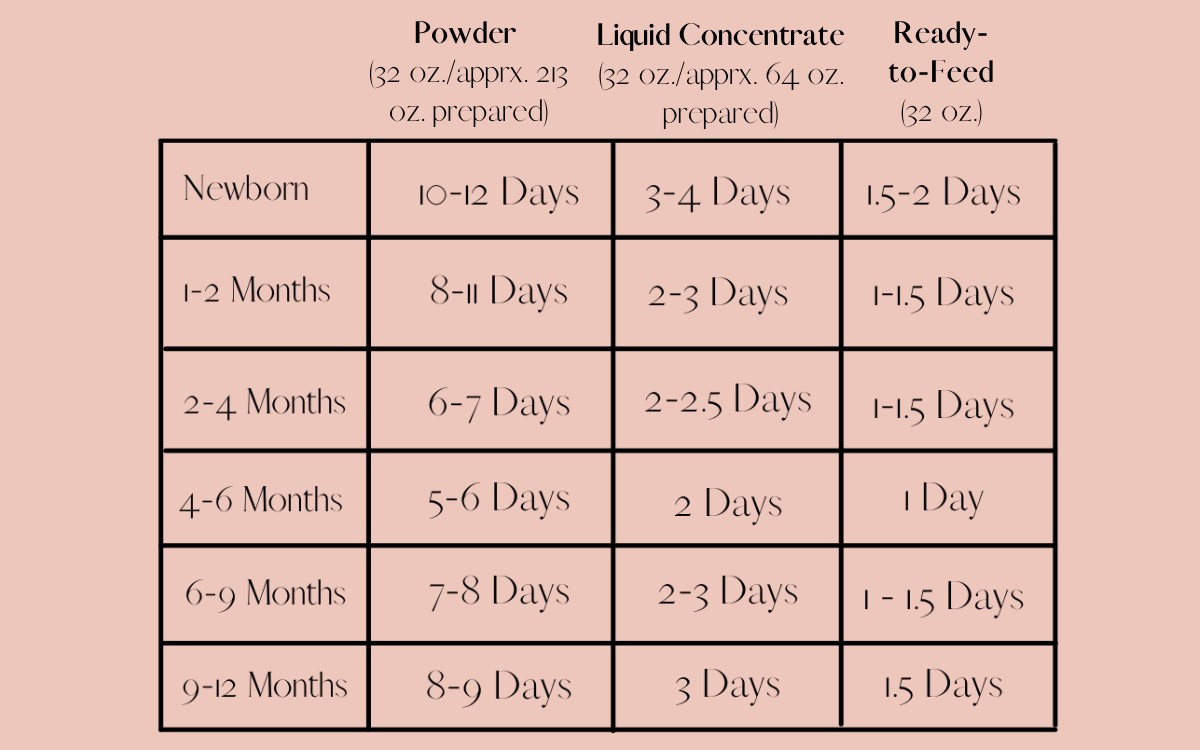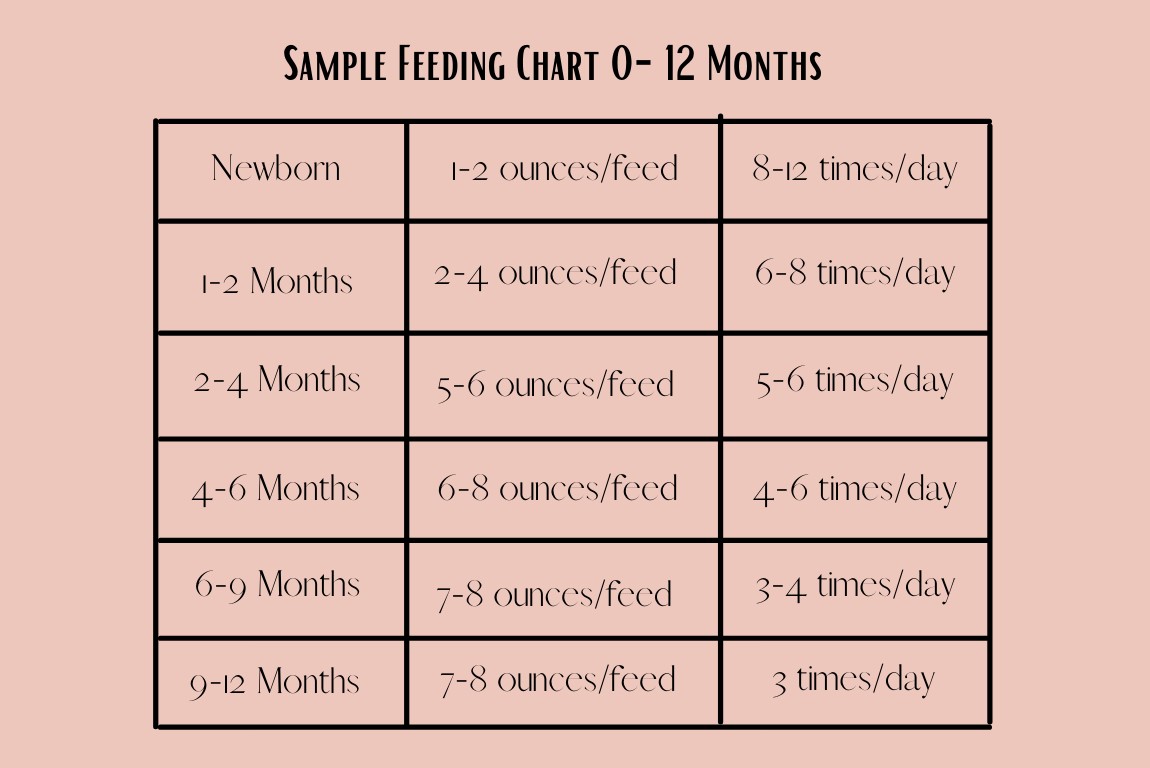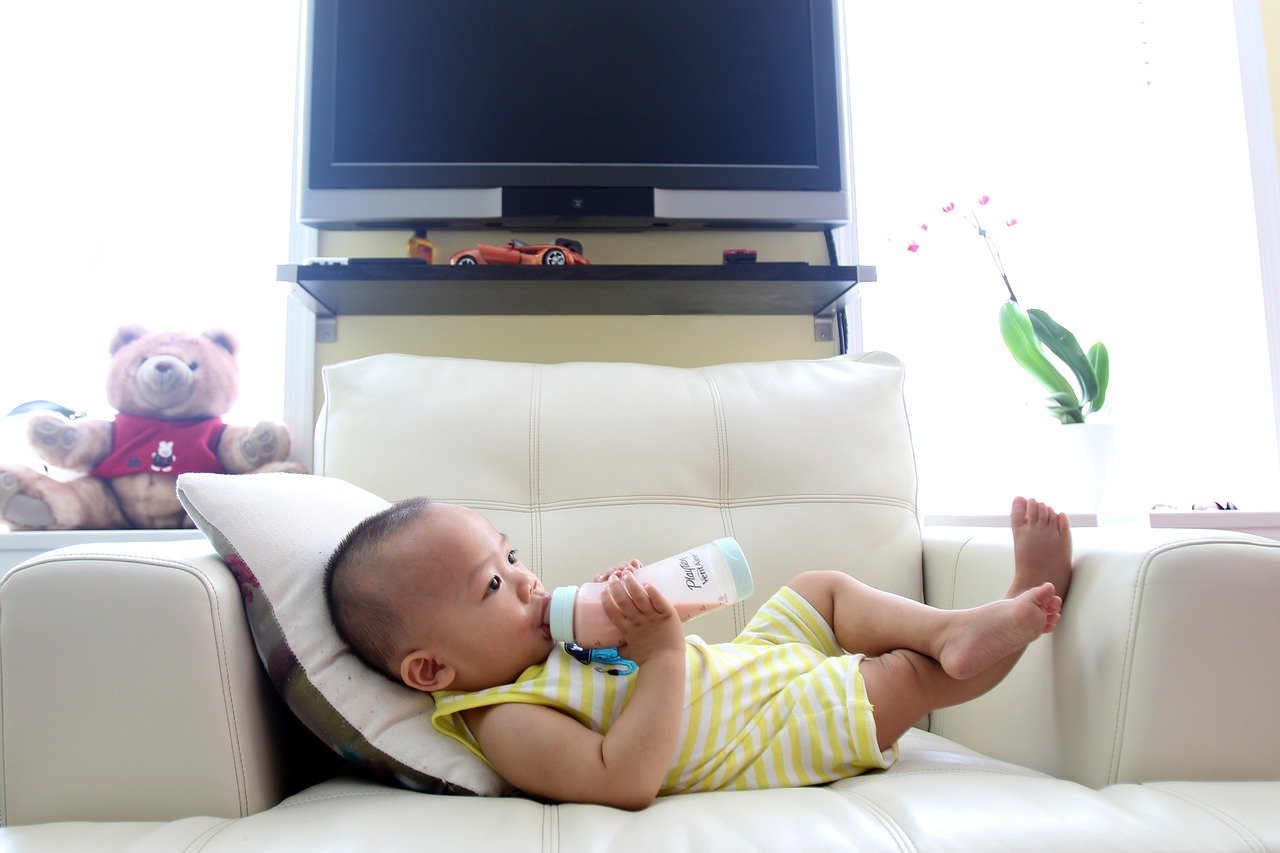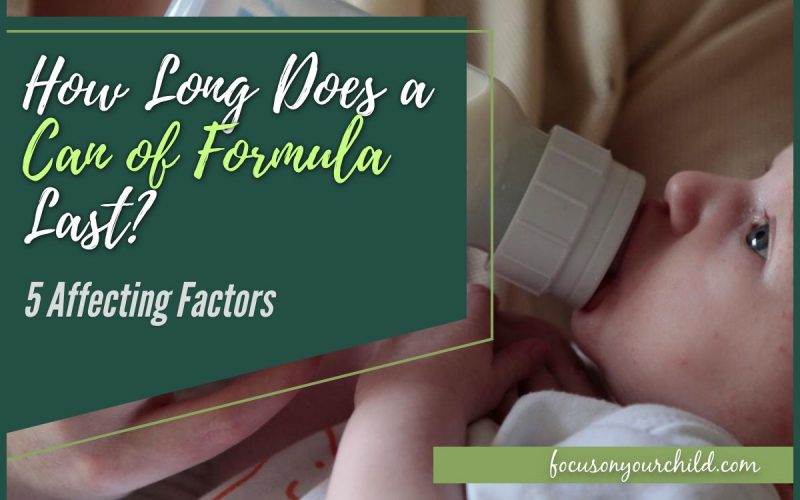How long a can of formula lasts depends on multiple factors, including:
- the size and amount of powder formula a single can has
- your baby’s age
- the volume and frequency of each feed
- type of formula
- whether you are exclusively formula feeding or using a formula to supplement breast milk
Below is a list of approximately how long a 32-ounce container of formula lasts, based on your baby’s age and the type of formula you are giving them.

This article lists the factors that affect how long a can of baby formula lasts, as well as how each factor will affect how long your formula supply lasts.
Factors Affecting How Long a Can of Formula Lasts
Size and Volume of Can
The first and probably most obvious factor is how large of a can of formula you have. Larger cans last longer than smaller cans. Larger cans may also cost less than small cans ounce for ounce.
Be aware of expiration dates and shelf-life when buying large containers of formula. Keep in mind that once opened, powder formula needs to be used within 1 month. Liquid and ready-to-feed formula need to be refrigerated and fed within 48 hours. Any unused formula must be discarded after its shelf life or expiration date has elapsed.
Baby’s Age and Weight

Weight
Unlike breast milk which will change in composition and volume to keep up with your baby’s needs, you will need to increase or decrease the amount of formula you give your baby with each feed as to provide them with adequate nutrition as they continue to grow.
As a guide, babies under the age of 6 months who haven’t been weaned onto purees yet should be drinking two and a half ounces of prepared liquid formula per pound of their body weight per day.
The amount and frequency at which your baby feeds will also change with age. Older babies will need more formula at each feed but will also feed less frequently than younger babies.
Age
Your baby will start to need less formula once they start to readily accept purees and solids, usually around 9 months of age. By this age, half of your baby’s caloric needs will come from food and the other half from the formula. By this age, babies usually need 7-8 ounces at each feeding, 3 times a day.
Toddlers who are a year old will usually be eating 3 meals and 2-3 snacks a day. By this time, your baby no longer needs formula, and you can start gradually transitioning to regular full-fat whole milk 2-3 times a day.
All toddlers are different, however, and yours may not wean off formula as easily. Other times, toddlers dislike drinking milk. In that case, it is perfectly alright to continue formula feeding a little longer while looking at different methods to introduce your baby to whole milk, sneak it into their diet, or find alternative foods which will provide them with necessary nutrients milk has.
Type of Formula
Formula can come in powdered, liquid concentrate, and ready-to-feed formulations which are sold in different volumes. Depending on the preparation required, some formulations will last more feeds than others.
All 3 formulations have the same nutritional content, so the type of formula you choose for your baby is entirely personal and revolves around what is most convenient and works best for you and your baby.
Ready-To-Feed
Of the 3 formulations, ready-to-feed infant formula is the most convenient – there is no need to dilute, which makes traveling with your baby more convenient. Babies who are given ready-to-feed formula are also less likely to be constipated. It is, however, also the most expensive option for formula feeding.
Because opened ready-to-feed formula has a relatively short shelf-life of just up to forty-eight hours, it usually comes in small bottles between 2 ounces and 32 ounces. Depending on your baby’s nutritional needs and formula container size, a container of ready-to-feed formula may feed a baby for anywhere between one and two days.
Liquid Concentrate
Similar to ready-to-feed formula, liquid concentrate has a 48-hour shelf life once opened. Similar to powders, they need to be diluted in water before feeding. Unlike powders which are scooped out, liquid concentrate formula needs to be measured out in a 1:1 (or according to manufacturer’s instruction) ratio with water.
Liquid concentrate also comes in small quantity containers to avoid waste and spoiling. Most commonly available are 13-ounce cans, which equals 26 fluid ounces of prepared formula.
Powder
Powdered formula is the most economical option for formula feeding. Powdered formula is usually cheaper than liquid formulas and can easily be bought in bulk. For some babies, powder formula can cause constipation, so if know your baby is prone to becoming constipated, stick to liquid options for formula.
Powdered infant formula has the longest shelf-life of the three types of formula – up to 30 days once opened, and thus can be bought in much larger quantities than liquid concentrate and ready-to-feed formulas. Powdered formula manufacturers usually include a measuring scoop in their powdered formula to allow for more accurate measurement.
Depending on the size, a can of powdered formula can make anywhere between 90 and 200 ounces of prepared liquid. Unlike liquid formulas, powdered infant formula is not sterile and should not be fed to premature babies and babies who may be immunocompromised.
Usage

Some people formula feed their babies exclusively, in which case you would need more product to meet your baby’s needs. You may also opt to breastfeed your baby and supplement feedings with formula. If you plan to breastfeed more often and formula feed occasionally, a can of formula would last you longer than a same-sized can would if you were to exclusively formula feed. In such a case, you may also want to choose smaller containers of formula to avoid ending up with spoiled or unusable leftover product.
Some people prefer to combine formula with expressed breastmilk in one bottle for feeding their baby. When combining formula and breast milk, prepare the formula in the bottle first before adding in the breastmilk. Never substitute water with breastmilk when preparing formula.
How Long Does Prepared Formula Last?
Once opened, a container of liquid concentrate or ready-to-feed formula must be refrigerated and used within 48-hours. Prepared powder or liquid concentrate formula in drinking bottles must be refrigerated and used within 24-hours. Similarly, formula combined with breastmilk must be refrigerated and used within 24-hours.
At room temperature, prepared formula is good for 2 hours. Once the bottle has been warmed or feeding has begun, discard any remaining formula within 1-hour, as bacteria can multiply fast in cow-based products.
How Long Does a Can of Formula Last: The Verdict
How long a can of infant formula will last you depends on a multitude of ever-changing factors. As your baby grows and gets older, their dietary needs will change. Whether you use liquid or powder formula will also affect how long your supply of formula will last.
The same can of formula you just picked up may not last you as long as the same can did last time. If you decide to start breastfeeding your baby in addition to formula feeding or your baby starts eating solids earlier, you may find that you suddenly have an over-supply of formula.
While figuring out how long a can of formula lasts and how much you need to buy at once may seem like a lot of guesswork, you will soon find out what works best for you and your baby.
